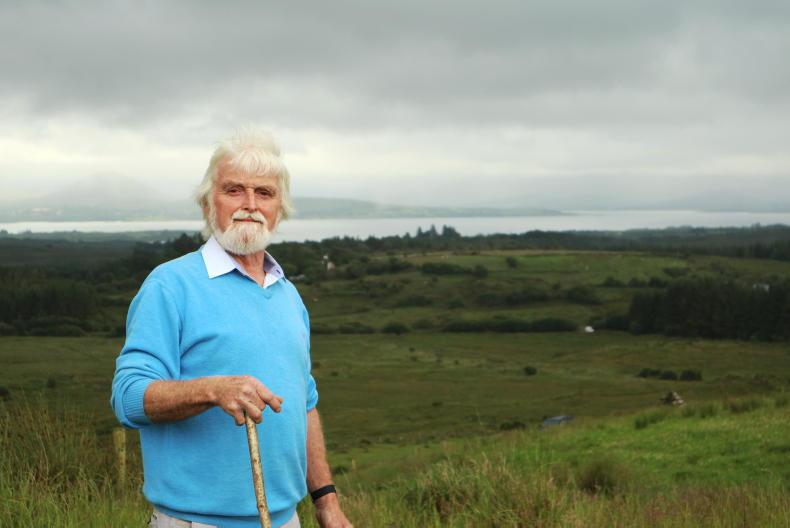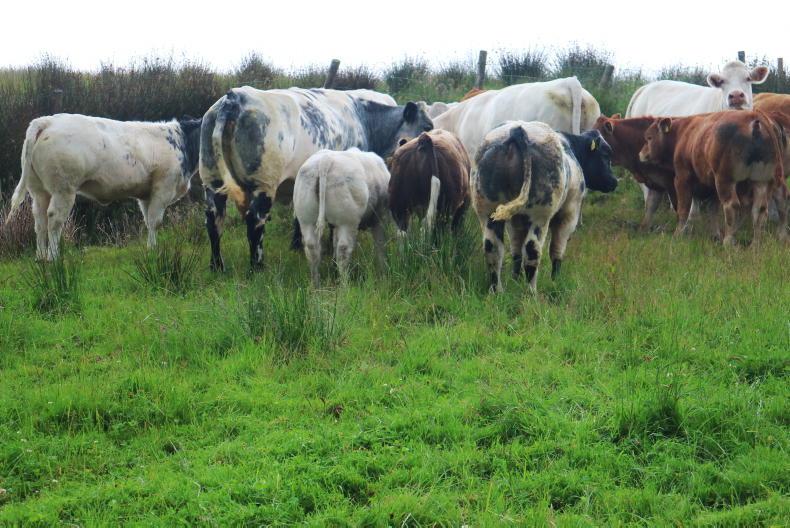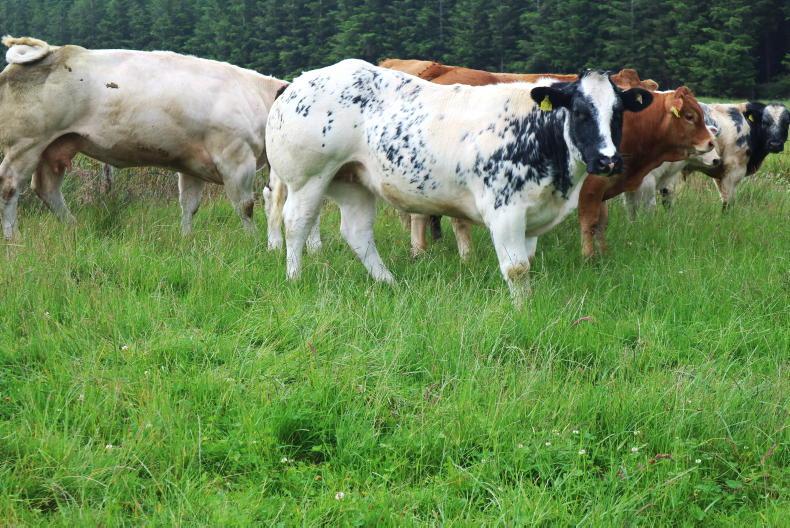I did it my way – the famous lyrics sung by Frank Sinatra came into my head as I trudged up the side of a south Kerry mountain following Sneem suckler farmer Tim O’Sullivan on a damp autumn evening.
I stopped a few times asking Tim could I take in the view but, really, I was trying to take a breath.
Kerry bucks the trend when it comes to suckler cows. It’s the only county in Ireland that showed a marginal increase in suckler cow numbers in 2020.

Tim O'Sullivan farms in Sneem, Co Kerry.
Things are different in Kerry – the land type, the cattle, the system, the people. And what stands out most is the passion that they have for their suckler cows.
As we walked, we talked about breeding of the cows, breeding of the calves and breeding, in general.
Tim, a retired school teacher, farms alongside his wife, Mary. They run a marginal farm on the Iveragh peninsula with seven different outfarms. Cattle at each location require herding every few days during the grazing season.
“It’s one of the challenges with this area. Fragmented farms add another layer of management that some people don’t understand,” Tim says.
Tim, like others in Kerry, farms the land his way. He has an autumn-calving suckler herd selling weanlings at 11 to 12 months of age at local weanling sales.

Dairying or dairy-beef systems just won't thrive on the marginal land according to Tim.
Autumn calving is amazingly popular in the area. A combination of tough weather conditions, high rainfall, long winters and marginal land means autumn calving is the system of choice for a lot of suckler farmers in Kerry.
Autumn calving means cows are generally weaned going back out of the shed in spring. Weanlings stay on the good lowland area of the farm while the dry cows head up to the hills for the summer. In July/August, they come back down closer to the yard areas for calving. Some farmers send cows back up to the foothills again in advance of housing in October.

Tim and his wife Mary run a marginal farm on the Iveragh peninsula with seven different outfarms.
It’s generally a six-month winter in this part of the country so sheds are important. Most have ample creep areas for young calves to continue sucking cows during the winter months.
A focus is put on making as good a quality silage as possible for the cows that are sucking calves during the winter months. Calves are also creep fed concentrates in winter.
“Our options are very limited in these parts.
“On marginal land, your options are restricted in any county but they are particularly restricted in this part of Kerry,” Tim says.
“Aside from suckler cows, there is only really sheep or forestry. You need to be well set up with fences for sheep so that isn’t an option for myself and due to planning laws you can’t get planning permission for forestry.
“Tourism is big business for south Kerry and, because of the need to protect the landscape for the visitors, forestry is all but banned in the region.
“Dairying or dairy beef systems won’t work on this marginal land, so it’s back to the suckler cow and doing the very best job of it.”
The herd is unique in that Tim has been using AI since it started back in the late 1960s.

The O'Sullivans have been using 100% AI on the farm since 1976.
“My father was actually the one of the first men in the area to try it out. The fragmented nature of our farm would mean that you would need a few bulls every year to service the herd. The beauty of AI meant that it didn’t matter where the cow was, she still got served,” Tim said.
It’s been 100% AI on this farm since 1976. “When I was a school child, one of my jobs was to drop into the public phone box in the village to make a call to Kenmare Creamery as we had no phone at the time.”
Typical of small suckler farms all over the country, there is an emphasis on quality stock rather than big numbers.
Tim has built up a strong customer base for his stock, with a number of repeat customers coming back to him to purchase pedigree bulls every year. Many of the bulls sold are pedigree but not registered.
All replacements are bred on the farm, with no stock purchased into the herd in the last 40 years.
“I use the replacement index as a tool but you need to be careful to pick a balanced bull and not lose an eye for stock,” Tim said.
It’s working, with Tim regularly getting between €1,000 and €1,300/head for his 2020-born weanlings this year.
I did it my way – the famous lyrics sung by Frank Sinatra came into my head as I trudged up the side of a south Kerry mountain following Sneem suckler farmer Tim O’Sullivan on a damp autumn evening.
I stopped a few times asking Tim could I take in the view but, really, I was trying to take a breath.
Kerry bucks the trend when it comes to suckler cows. It’s the only county in Ireland that showed a marginal increase in suckler cow numbers in 2020.

Tim O'Sullivan farms in Sneem, Co Kerry.
Things are different in Kerry – the land type, the cattle, the system, the people. And what stands out most is the passion that they have for their suckler cows.
As we walked, we talked about breeding of the cows, breeding of the calves and breeding, in general.
Tim, a retired school teacher, farms alongside his wife, Mary. They run a marginal farm on the Iveragh peninsula with seven different outfarms. Cattle at each location require herding every few days during the grazing season.
“It’s one of the challenges with this area. Fragmented farms add another layer of management that some people don’t understand,” Tim says.
Tim, like others in Kerry, farms the land his way. He has an autumn-calving suckler herd selling weanlings at 11 to 12 months of age at local weanling sales.

Dairying or dairy-beef systems just won't thrive on the marginal land according to Tim.
Autumn calving is amazingly popular in the area. A combination of tough weather conditions, high rainfall, long winters and marginal land means autumn calving is the system of choice for a lot of suckler farmers in Kerry.
Autumn calving means cows are generally weaned going back out of the shed in spring. Weanlings stay on the good lowland area of the farm while the dry cows head up to the hills for the summer. In July/August, they come back down closer to the yard areas for calving. Some farmers send cows back up to the foothills again in advance of housing in October.

Tim and his wife Mary run a marginal farm on the Iveragh peninsula with seven different outfarms.
It’s generally a six-month winter in this part of the country so sheds are important. Most have ample creep areas for young calves to continue sucking cows during the winter months.
A focus is put on making as good a quality silage as possible for the cows that are sucking calves during the winter months. Calves are also creep fed concentrates in winter.
“Our options are very limited in these parts.
“On marginal land, your options are restricted in any county but they are particularly restricted in this part of Kerry,” Tim says.
“Aside from suckler cows, there is only really sheep or forestry. You need to be well set up with fences for sheep so that isn’t an option for myself and due to planning laws you can’t get planning permission for forestry.
“Tourism is big business for south Kerry and, because of the need to protect the landscape for the visitors, forestry is all but banned in the region.
“Dairying or dairy beef systems won’t work on this marginal land, so it’s back to the suckler cow and doing the very best job of it.”
The herd is unique in that Tim has been using AI since it started back in the late 1960s.

The O'Sullivans have been using 100% AI on the farm since 1976.
“My father was actually the one of the first men in the area to try it out. The fragmented nature of our farm would mean that you would need a few bulls every year to service the herd. The beauty of AI meant that it didn’t matter where the cow was, she still got served,” Tim said.
It’s been 100% AI on this farm since 1976. “When I was a school child, one of my jobs was to drop into the public phone box in the village to make a call to Kenmare Creamery as we had no phone at the time.”
Typical of small suckler farms all over the country, there is an emphasis on quality stock rather than big numbers.
Tim has built up a strong customer base for his stock, with a number of repeat customers coming back to him to purchase pedigree bulls every year. Many of the bulls sold are pedigree but not registered.
All replacements are bred on the farm, with no stock purchased into the herd in the last 40 years.
“I use the replacement index as a tool but you need to be careful to pick a balanced bull and not lose an eye for stock,” Tim said.
It’s working, with Tim regularly getting between €1,000 and €1,300/head for his 2020-born weanlings this year.










 This is a subscriber-only article
This is a subscriber-only article











SHARING OPTIONS: